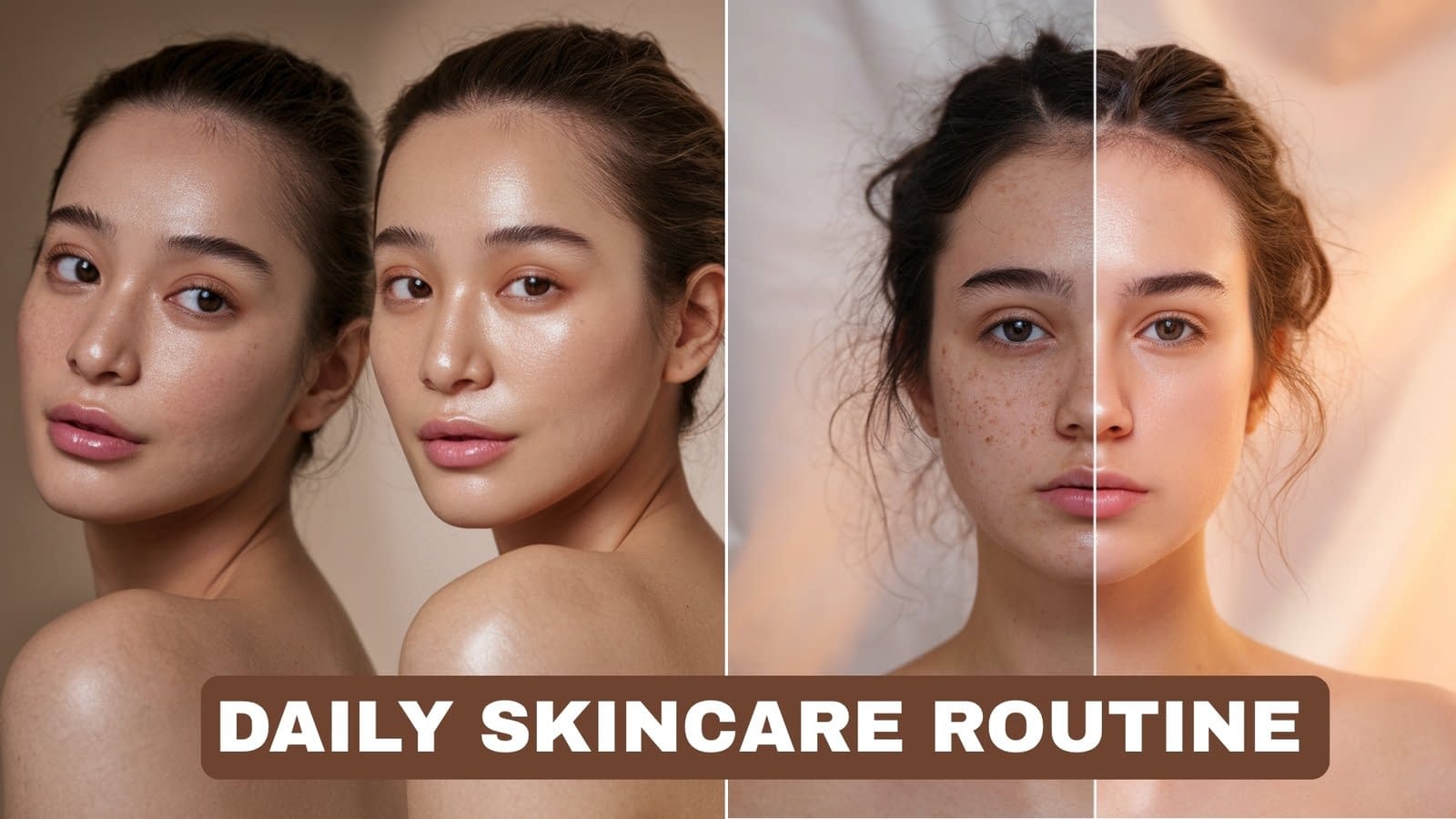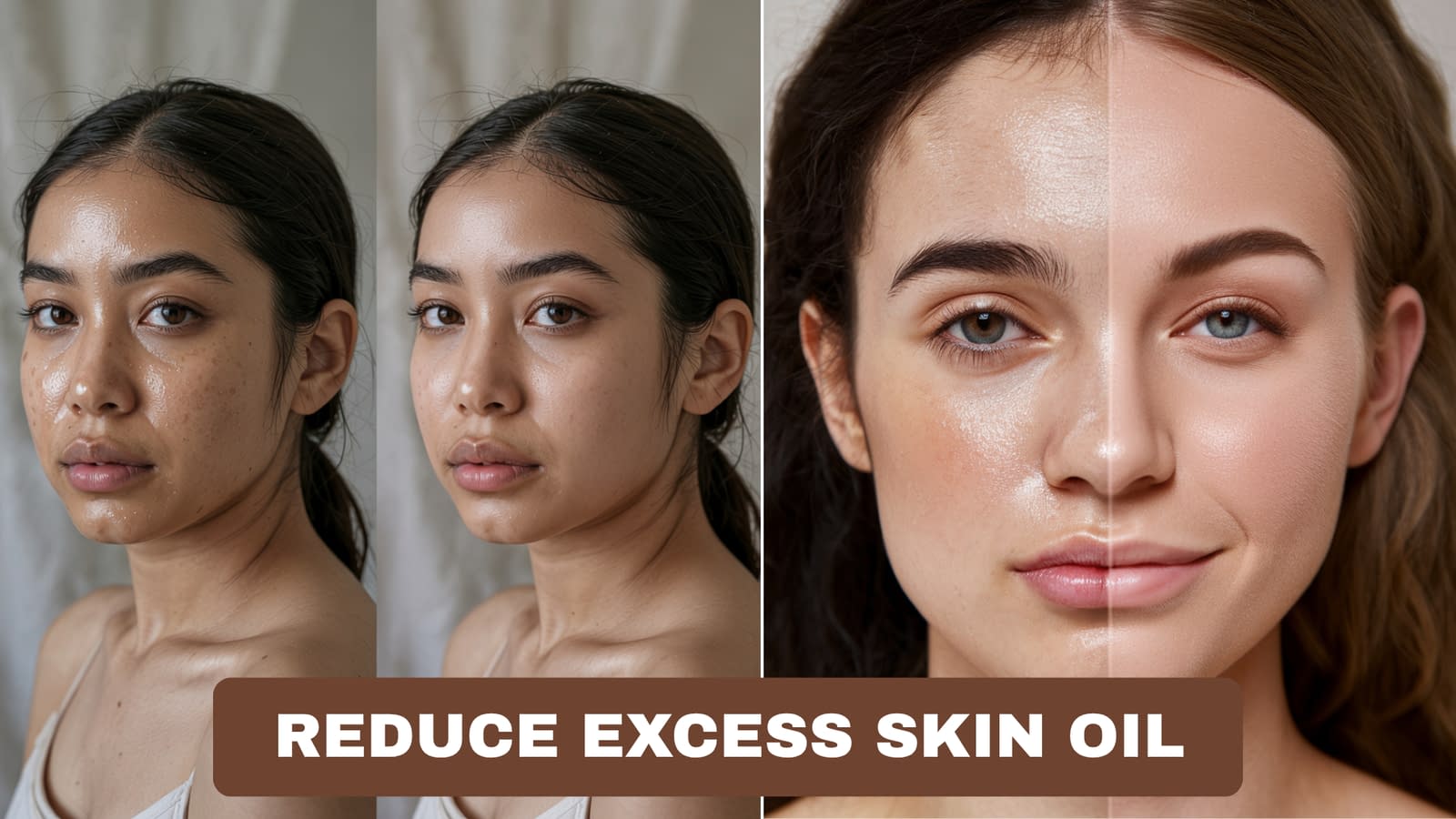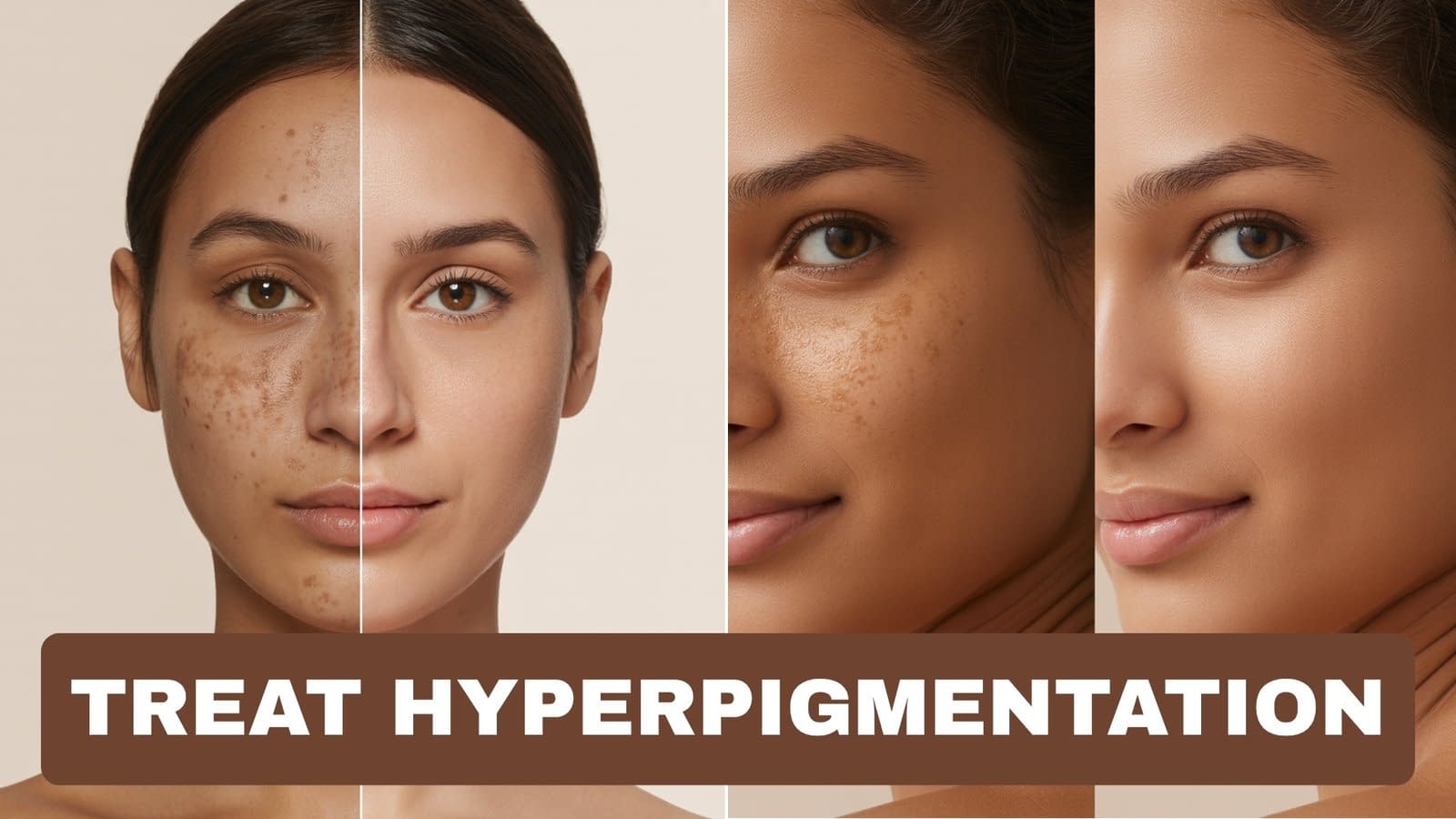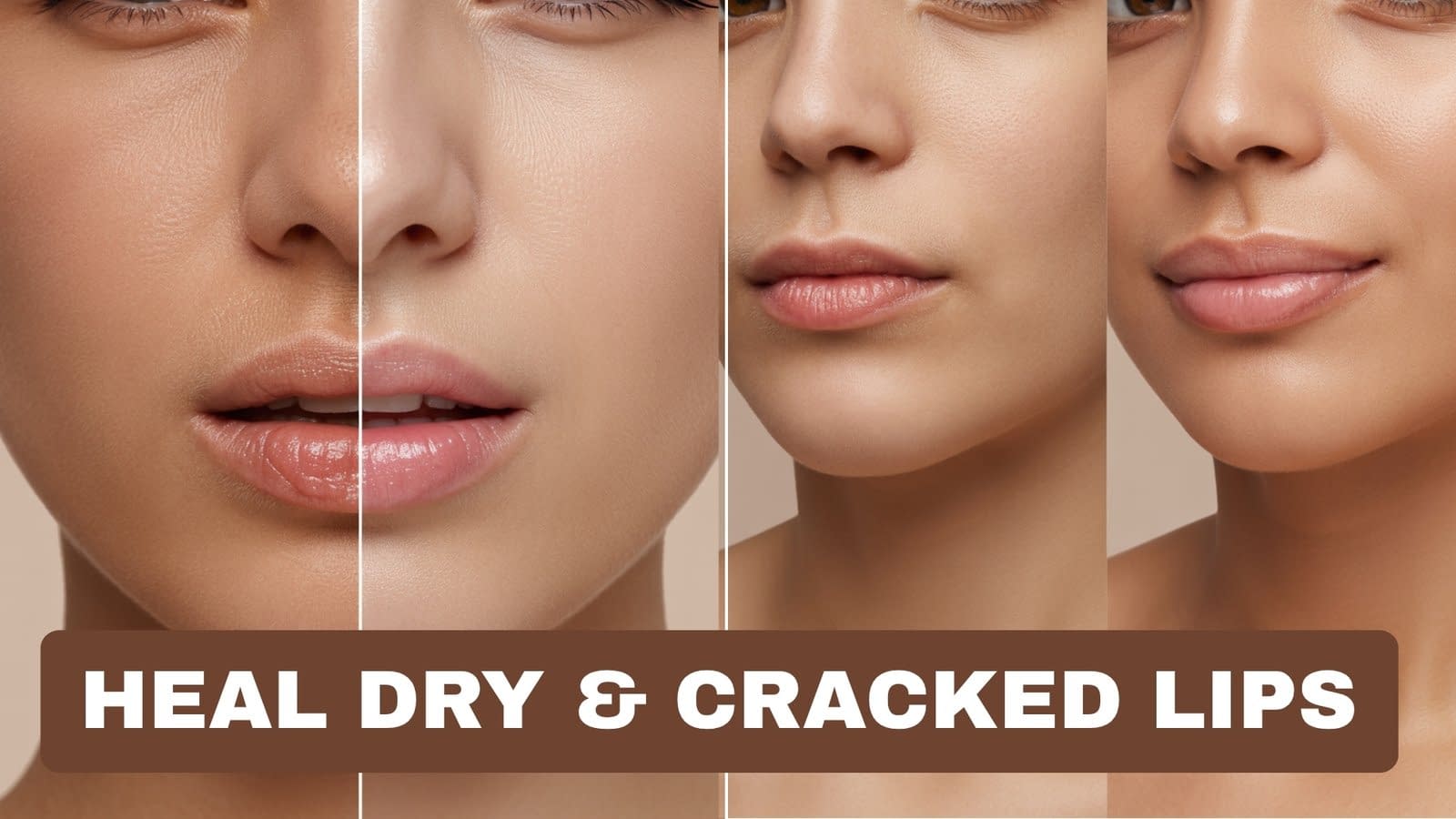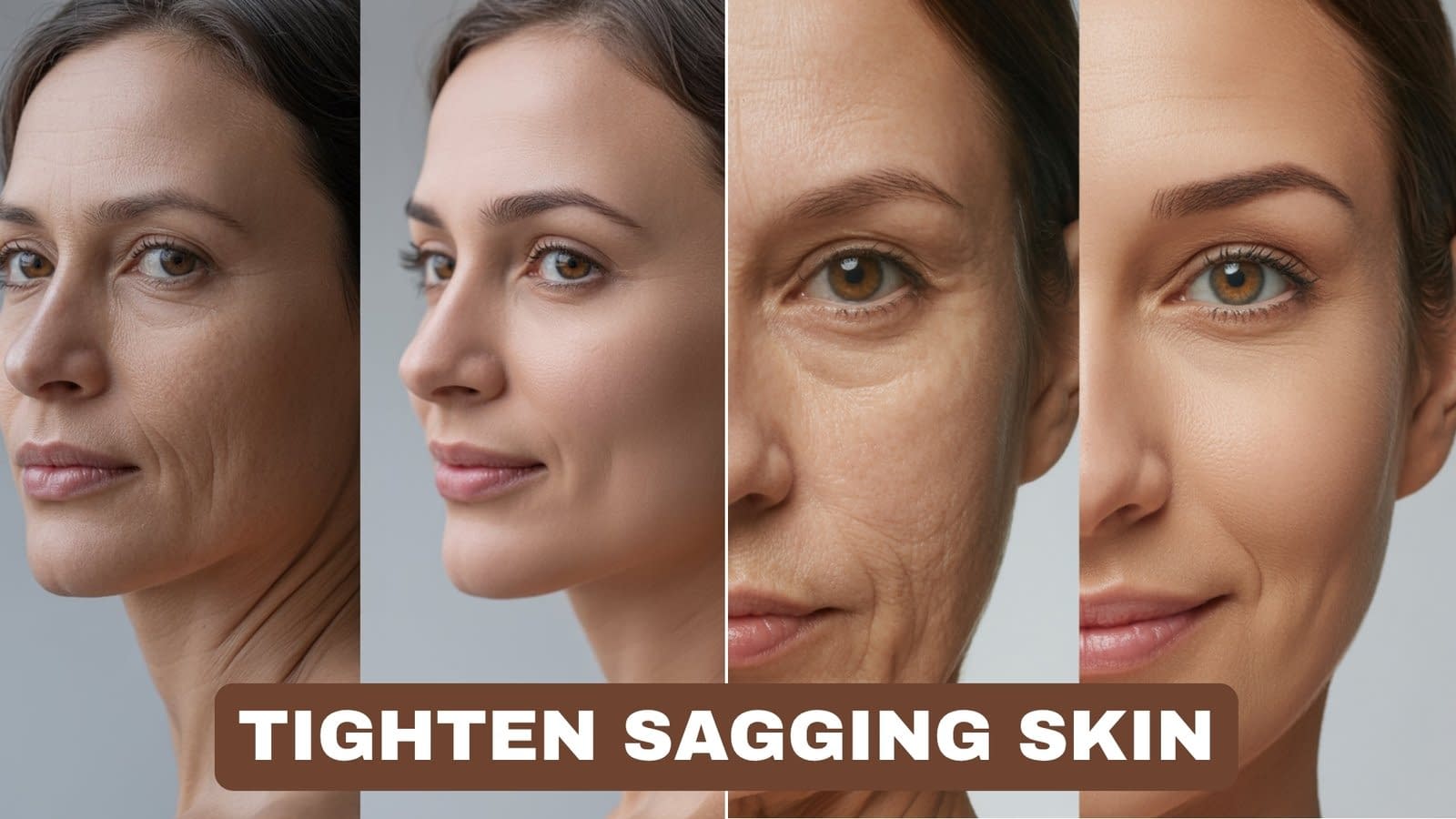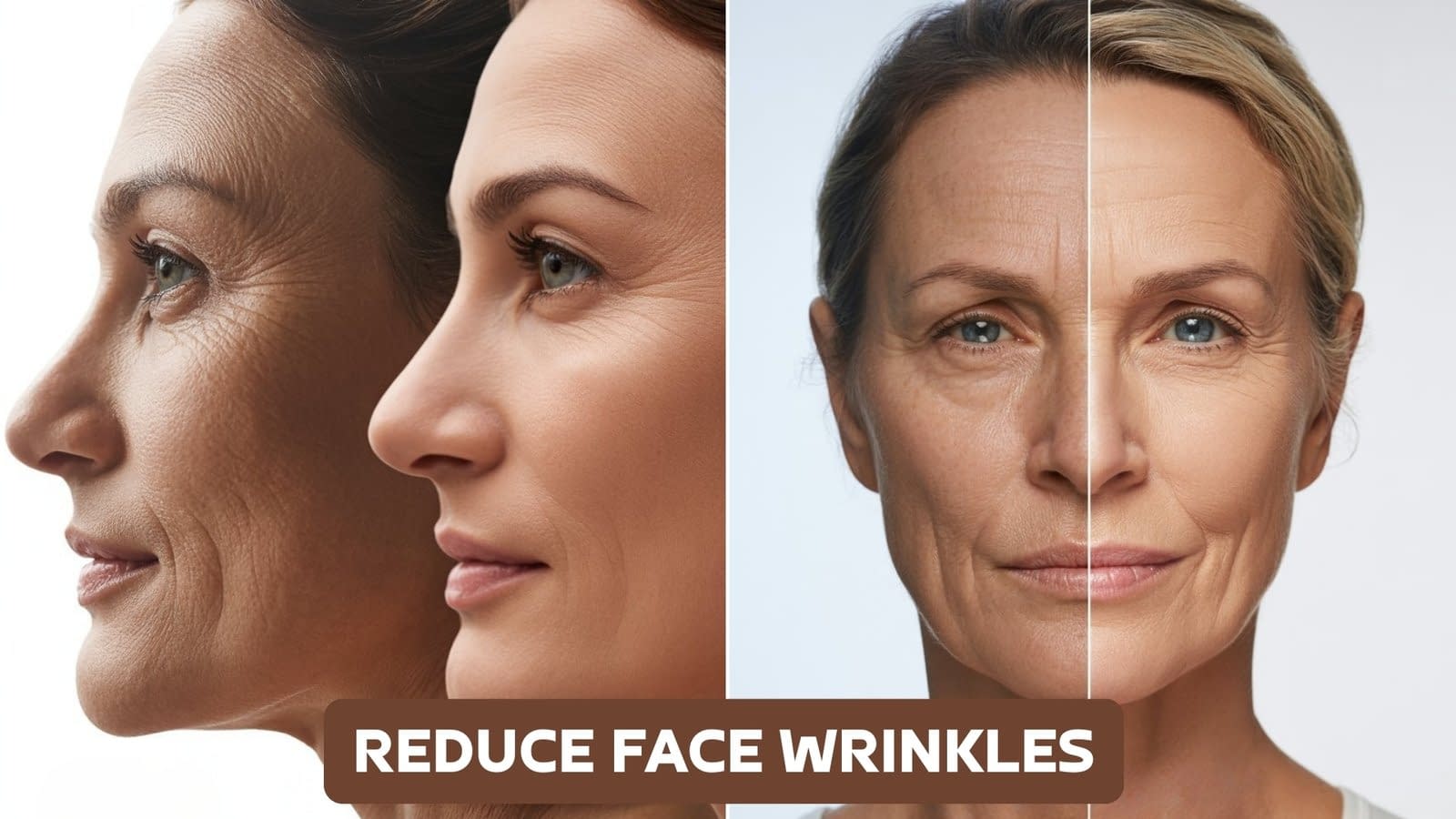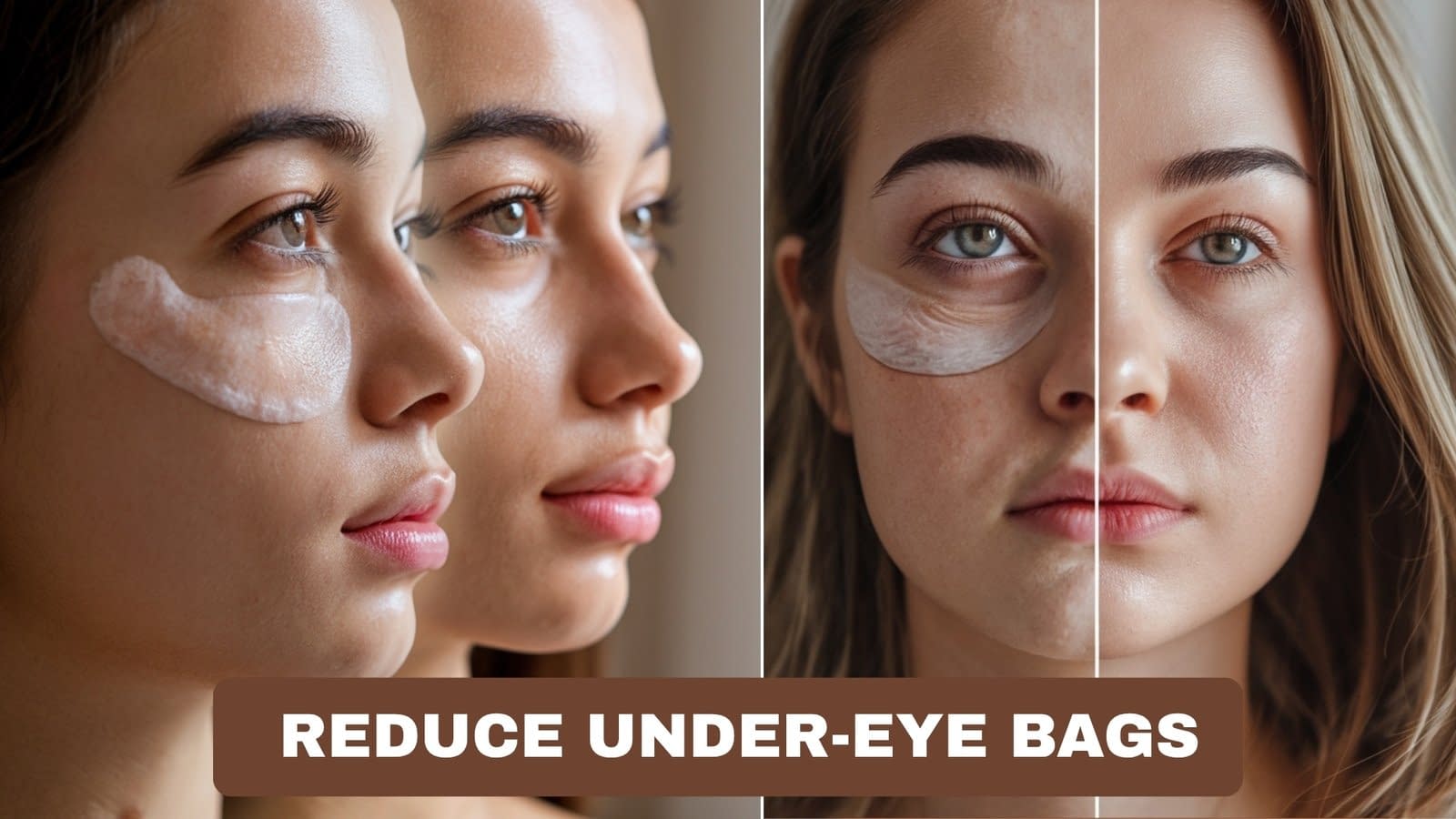A simple, consistent skincare routine is one of the best things you can do for healthier-looking skin. Whether you’re overwhelmed by product claims or don’t know where to start, this guide breaks everything down into clear, practical steps — what to do in the morning vs. night, how to pick the right products for your skin type, safe ways to use active ingredients like retinol, budget-friendly options, and weekly care that actually helps. Read it like a map: follow the step-by-step sections and adapt them slowly — consistency beats complexity.
Why a Daily Skincare Routine Matters
A daily routine isn’t about perfection — it’s about predictable, gentle care that supports your skin’s natural functions.
Why routines work:
- Barrier support: Regular cleansing, moisturizing, and protecting helps maintain the skin barrier so moisture stays in and irritants stay out.
- Prevention > repair: Sun protection and antioxidants reduce long-term damage (pigmentation, early aging).
- Consistency builds results: Acne, texture, and tone improve when treatments are applied regularly. You’ll see changes in weeks, not days.
- Saves money/time: A focused routine avoids impulse buys and product overload.
Practical mindset: aim for a simple core — cleanse, treat (serum), moisturize, sunscreen (AM). Add targeted steps as you learn what your skin tolerates.
Know Your Skin: How to Identify Your Skin Type
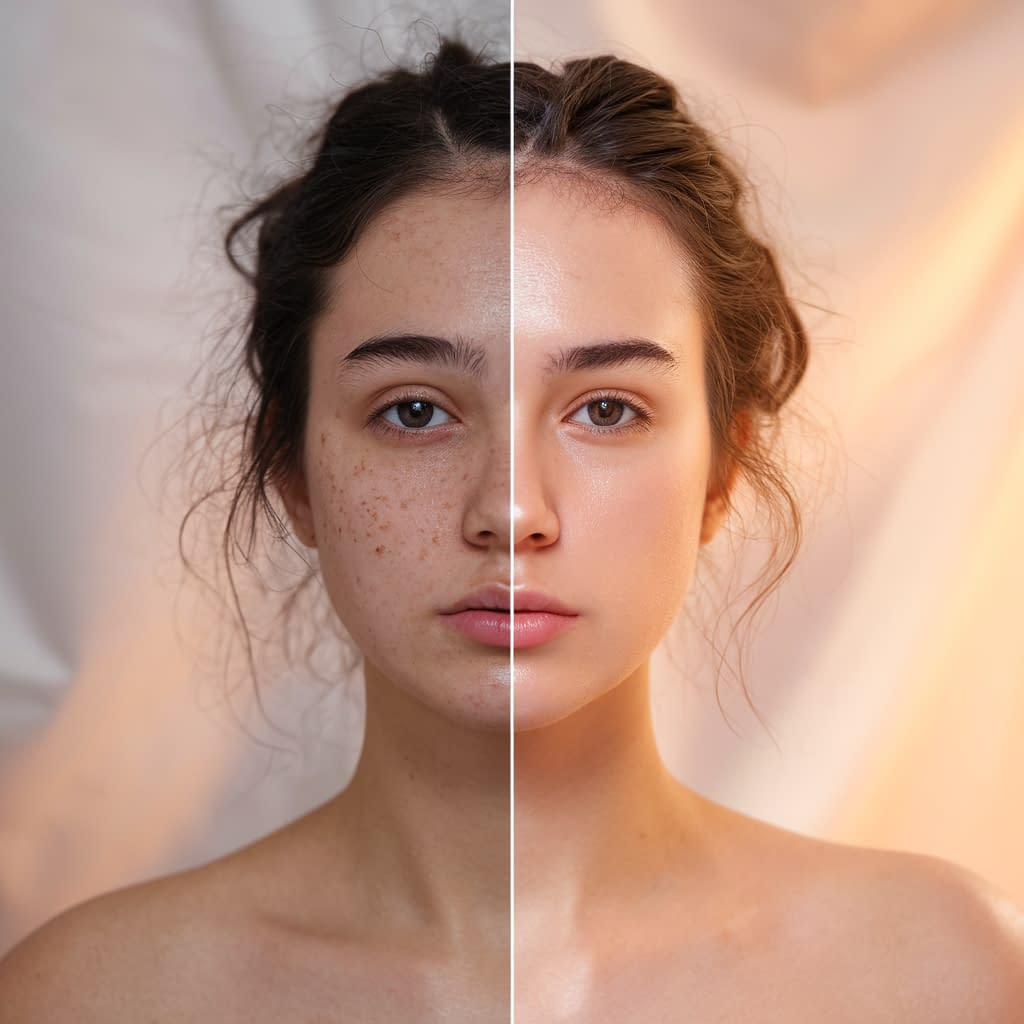
Identifying your skin type first prevents buying products that over-dry, over-oil, or irritate.
Quick home test (clean-face method):
- Wash your face with a gentle cleanser and pat dry.
- Wait 1 hour without applying products.
- Observe:
- Oily: Shine across forehead, nose, chin (T-zone) and visible pores.
- Dry: Tightness, flakiness, or rough patches; fine lines more noticeable.
- Combination: Oily T-zone, drier cheeks.
- Normal: Balanced, no extreme dryness or oil; few blemishes.
- Sensitive: Redness, stinging or burning easily after products or exposure.
Also consider:
- Acne-prone: Frequent breakouts — may be oily, but not always.
- Dehydrated skin: Feels tight but not necessarily dry — look for dullness and fine lines; hyaluronic acid helps.
- Reactive/sensitized: Redness, rash after ingredients — choose fragrance-free, minimal routines.
How to track: Keep a 2-week skin diary (product used, reactions, oiliness, new pimples) to confirm type and triggers.
Morning vs. Night Routine – What’s the Difference?
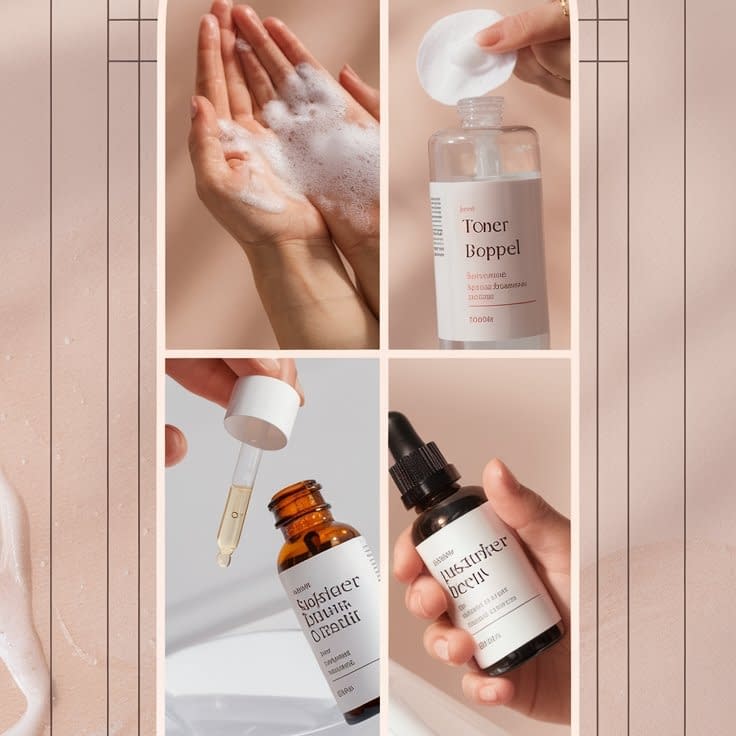
Think of AM as defend, PM as repair.
- Morning (Defend): Cleanse → hydrate/treat lightly → moisturize → sunscreen. Add antioxidant serums (vitamin C) to protect from free radicals and pollution.
- Night (Repair): Cleanse (double-cleanse if wearing sunscreen/makeup) → treatment serums (retinol, AHA/BHA at recommended frequencies) → richer moisturizer or sleeping mask. Night is when skin renews, so actives work best then.
Key differences:
- Use sunscreen every morning. Don’t swap it for makeup.
- Stronger actives (retinol, chemical exfoliants) are usually night-only and used sparingly to avoid irritation.
- Hydration steps (hyaluronic acid) can be both AM and PM.
Step 1: Cleanse – Start with a Fresh Base
Why cleansing matters:
- Removes oil, dirt, sweat, sunscreen, makeup — giving other products a chance to work.
- Should not strip the skin barrier.
How to choose a cleanser:
- Oily/acne-prone: Gel or foaming cleanser with salicylic acid (BHA) 0.5–2% can help break down oil and unclog pores. Don’t overuse — once or twice daily is enough.
- Dry/sensitive: Cream, milk, or oil cleanser (non-foaming) to hydrate while cleansing.
- Combination: Gentle gel or cream; use oil-targeted cleanser on T-zone if needed.
- Normal: Gentle foaming or cream cleanser works.
Step-by-step cleansing (AM):
- Wet face with lukewarm water.
- Dispense a dime- to nickel-sized amount of cleanser.
- Massage gently for 30–60 seconds — cover all zones (forehead, cheeks, nose, jawline).
- Rinse thoroughly with lukewarm water.
- Pat dry with a clean towel (don’t rub).
Double cleanse (PM, if wearing sunscreen/makeup):
- First: Oil-based cleanser or micellar water to remove makeup and sunscreen.
- Second: Your usual gentle cleanser to remove residue and impurities.
- Rinse and pat dry.
Common mistakes:
- Using hot water — it strips oils.
- Over-cleansing — can cause rebound oiliness or dryness. Stick to twice daily maximum unless skin is very oily or sweaty.
Step 2: Tone – Balance and Prep Your Skin
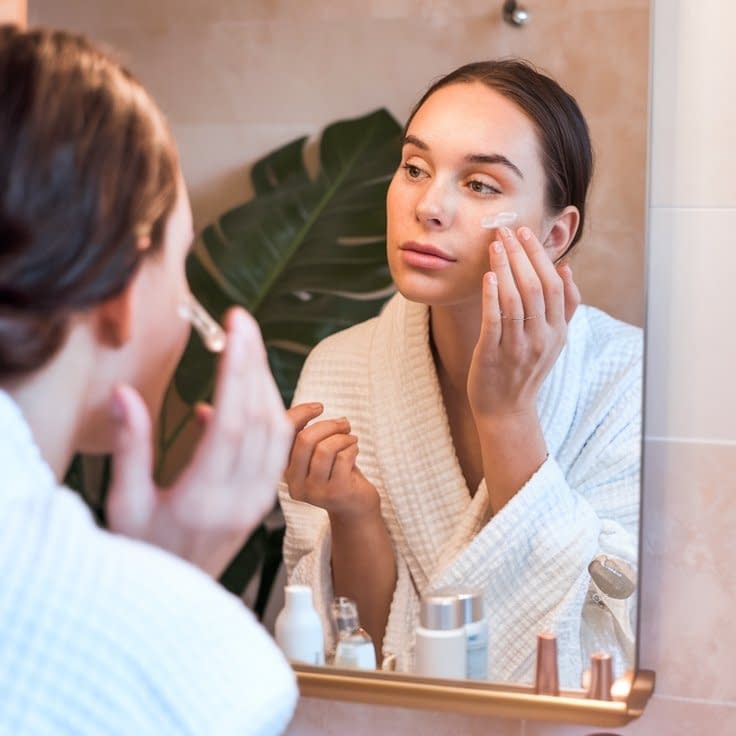
Toners today are not about “pH reset” only — they prep the skin, add light hydration, or deliver treatment ingredients.
Types of toners and which to choose:
- Hydrating toners (glycerin, hyaluronic acid, botanical humectants): Great for dry or dehydrated skin.
- Exfoliating toners (AHAs like glycolic/lactic, BHAs like salicylic acid): Use 1–3 times per week if you want chemical exfoliation; skip if skin is sensitive or you’re using strong actives.
- Soothing toners (aloe, panthenol, niacinamide): For sensitive/reactive skin.
- Astringent toners (high alcohol): Avoid — they can be drying and irritating.
How to apply:
- After cleansing, pour a few drops into your palm or onto a cotton pad (palm gives less waste).
- Gently pat or press into skin — don’t scrub.
- Wait 30–60 seconds before serums so the product absorbs.
Step-by-step examples:
- Hydrating route (AM/PM): Apply 3–5 drops hyaluronic acid-based toner to damp skin → press in → follow with serum.
- Exfoliating route (PM only, 1–3x/week): Use an AHA toner at night → skip other acids or retinol same night until you know how your skin tolerates combinations.
Safety tip: If you use chemical exfoliants, add sunscreen every morning — acids increase sun sensitivity.
Step 3: Serum – Target Skin Concerns
Serums are concentrated treatments for specific goals: hydration, brightening, anti-aging, acne control.
Common serum ingredients and when to use them:
- Hyaluronic acid (HA): Hydrates; works for all skin types. Apply on damp skin for best results.
- Niacinamide (vitamin B3): Balances oil, reduces redness, minimizes pore appearance. Fine for most skin types.
- Vitamin C (ascorbic acid or stable derivatives): Brightens, reduces oxidative damage — use in AM under sunscreen. Start at lower concentrations (5–10%) if sensitive.
- Azelaic acid: Good for redness, rosacea, pigment, and acne. Generally gentle.
- Salicylic acid (BHA): For acne-prone, oily skin — unclogs pores. Used in serums or leave-on spot treatments.
- Retinoids (retinol, retinaldehyde, prescription tretinoin): Anti-aging and acne; strong — use at night and slowly. See section 9 for safe use.
- Peptides: Support collagen — use AM or PM; generally well tolerated.
How to layer serums (general ordering):
- Lightest, water-based serums first (e.g., hyaluronic acid).
- Thicker or oil-based serums last (e.g., vitamin C oils, facial oils).
- If using both vitamin C (AM) and niacinamide, they’re compatible, but beginners may try one at a time to gauge tolerance.
Step-by-step serum application:
- Apply toner and wait a few seconds.
- Dispense 2–4 drops of serum onto fingertips.
- Gently press and smooth serum over face and neck — avoid stretching skin.
- Wait 30–60 seconds for absorption before moisturizer.
Frequency and patience:
- Most active serums take 4–12 weeks to show visible improvement (e.g., brightening, texture).
- Introduce one active at a time and patch-test first (apply a tiny amount to inner forearm for 48 hours).
Step 4: Moisturize – Lock in Hydration
Moisturizers keep skin barrier healthy and lock in serums. Everyone needs one — even oily skin.
How to choose:
- Oily/acne-prone: Lightweight gel or lotion with humectants and non-comedogenic oils; look for ingredients like niacinamide, glycerin.
- Dry: Creams with occlusives (shea butter, oils), ceramides, and humectants (glycerin, hyaluronic acid).
- Combination: Lighter across cheeks and a slightly heavier option for drier areas; or use one balanced moisturizer.
- Sensitive: Fragrance-free, minimal-ingredient formulas with barrier-repair actives (ceramides, panthenol).
How much to use:
- Face: A pea- to almond-sized amount depending on product thickness. Neck: don’t forget, use any leftover product and smooth downwards.
Step-by-step moisturizing:
- After serums, warm a small amount of moisturizer between your hands.
- Press into face and neck in upward motions — avoid rubbing.
- If your skin still feels tight after 10 minutes, add a second thin layer or a hydrating mist.
Layering with oils:
- If you use a facial oil, apply it after moisturizer as a sealant if your moisturizer is water-based, unless the oil product directions say otherwise.
Step 5 (Morning Only): Sunscreen – Your Skin’s Best Protection
Sunscreen is the single most important product to prevent premature aging, pigmentation, and skin cancer.
What to look for:
- Broad-spectrum protection (UVA + UVB).
- SPF 30 or higher (SPF 30 blocks ~97% of UVB; SPF 50 ~98%). SPF 30 is an excellent baseline.
- Mineral (physical) sunscreens: Zinc oxide or titanium dioxide — good for sensitive skin.
- Chemical sunscreens: Absorb UV; formulas tend to be lighter and cosmetically elegant.
How to apply:
- Apply after moisturizer (and after makeup if you layer).
- Use about 1/4 teaspoon for the face (or 1/2 teaspoon for face + neck), or apply enough so the product doesn’t rub off. Many people underapply.
- Rub gently until even. Wait 2–5 minutes before makeup.
- Reapply every 2 hours when outdoors, and immediately after swimming or heavy sweating.
Sunscreen tricks:
- For oily skin, choose a mattifying sunscreen or a gel formula.
- For acne-prone skin, pick “non-comedogenic” labeling.
- Tinted mineral sunscreens can double as light coverage foundation and are great for covering redness and providing antioxidant benefits.
Important note: No sunscreen blocks 100% UV, so combine with shade, hats, and sunglasses for maximal protection.
Night Routine Add-On: How to Use Retinol or Treatments Safely
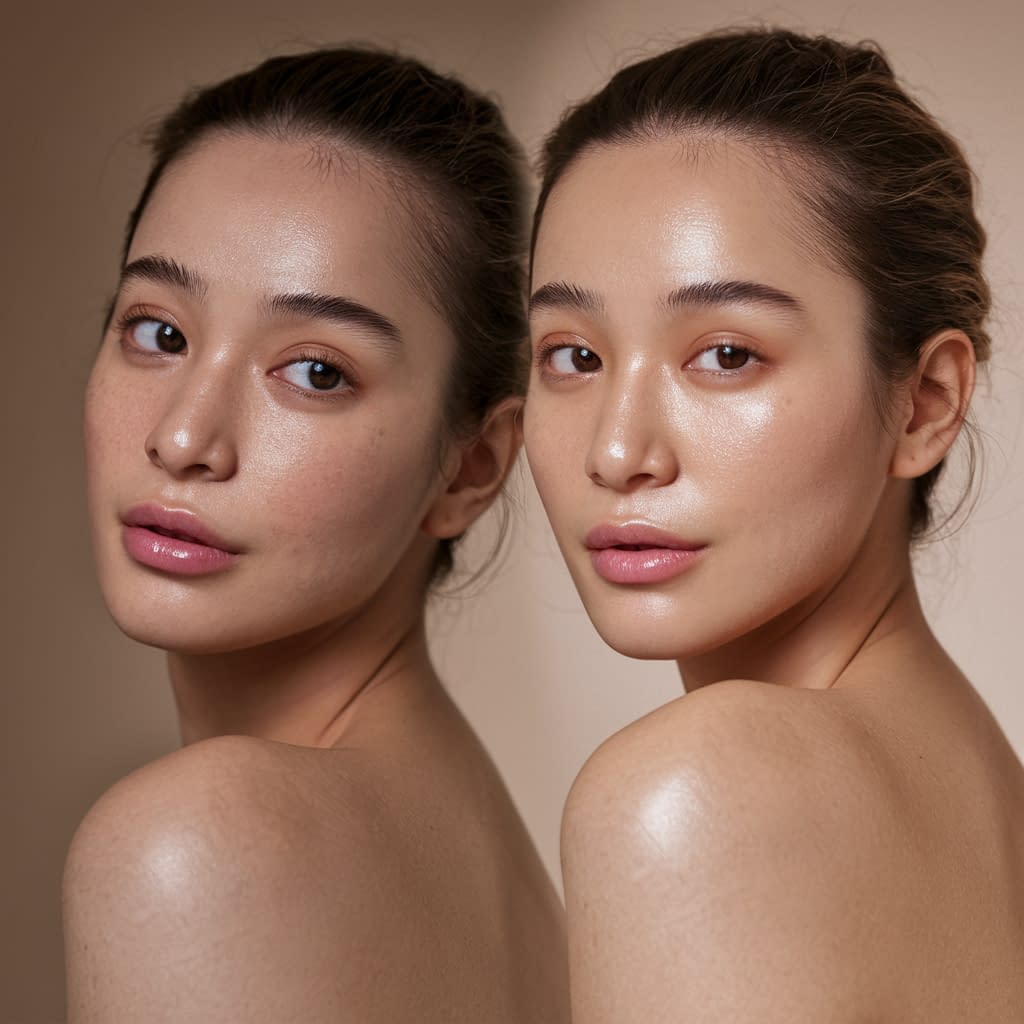
Retinoids are powerful for acne, texture, and aging — but they need careful introduction.
Types and strength:
- Retinol (OTC): Gentle but effective over months. Start low (0.25%–0.5%) if new.
- Retinaldehyde / Retinal: A step between retinol and prescription retinoids — faster acting but can still be tolerable.
- Tretinoin (prescription): Stronger, often reserved for dermatologist supervision.
How to introduce retinol safely:
- Start slow: Use 1–2 nights per week for the first 2–4 weeks.
- Patch test: Apply a small amount on the forearm for 48 hours before facial use.
- Buffering method (for sensitive skin): Apply moisturizer first, then retinol, or apply retinol and follow with moisturizer to reduce irritation. Some people mix a pea-sized amount of retinol with moisturizer before applying.
- Increase gradually: Move to every other night after 2–4 weeks if tolerated, then nightly as tolerated.
- Avoid with strong acids: Do not use retinol the same night as an AHA/BHA unless you know your skin tolerates both. Overlapping can cause excessive irritation.
- Sun caution: Retinoids increase sun sensitivity — always use morning sunscreen.
Signs of overuse:
- Redness, flaking, burning, extreme dryness. If this happens, stop for a few days, moisturize, and reintroduce more slowly or seek dermatologist advice.
Other night treatments:
- AHA/BHA: Glycolic/lactic acids (AHA) for texture and brightening; salicylic acid (BHA) for oily/acne-prone skin. Use night-only or as directed, 1–3 times weekly based on tolerance.
- Prescription actives: Use under dermatologist guidance.
When to see a professional:
- If irritation is severe or persistent. If you have pregnancy or breastfeeding concerns, consult your healthcare provider before using retinoids (retinoids are typically avoided during pregnancy).
Weekly Care: Exfoliation and Face Masks
Weekly care levels up your routine without daily risk.
Exfoliation:
- Physical exfoliation (scrubs, brushes): Use gently and sparingly. Not recommended for active acne, rosacea, or severely sensitive skin.
- Chemical exfoliation (AHA like glycolic/lactic, BHA like salicylic): More even results, less micro-tearing. Frequency: 1–3x/week depending on strength and skin tolerance.
- Enzyme exfoliants (papaya, pumpkin): Gentler alternative for reactive skin.
How to exfoliate safely:
- Start with once a week.
- Monitor for redness or prolonged sensitivity.
- Don’t combine strong chemical exfoliants with retinol on the same night unless you’re working with a dermatologist and your skin has built tolerance.
Face masks:
- Hydrating masks: Hyaluronic acid, glycerin, aloe — great for dry or dehydrated skin. Use 1–3x/week.
- Clay masks: Bentonite, kaolin — absorb excess oil, good for oily/combination skin. Use 1x/week.
- Brightening masks: Contain AHAs or vitamin C — use sparingly and avoid mixing with other strong actives.
Sample weekly schedule:
- Monday: PM – gentle AHA toner (if you use).
- Wednesday: Hydrating mask + serum.
- Friday: Clay mask for oily T-zone.
- Sunday: Rest / repair — just gentle cleanse + moisturizer.
Best Skincare Ingredients for Beginners
Start with a few tried-and-true, gentle ingredients that give measurable benefits.
Foundational ingredients:
- Niacinamide: Improves barrier function, controls oil, reduces redness. Very versatile.
- Hyaluronic Acid: Hydration powerhouse — plumps skin and reduces tightness.
- Ceramides: Repair and strengthen the skin barrier. Ideal for dry/sensitive skin.
- SPF (sunscreen): Prevents sun damage; mandatory AM product.
- Gentle chemical exfoliant (low % AHA/BHA): For texture and brightness, introduced slowly.
- Vitamin C (stable form): Brightens and fights oxidative damage — AM use under sunscreen.
- Salicylic acid: For acne/oily skin — unclogs pores and reduces inflammation.
Beginner regimen checklist:
- Cleanser (gentle), Hydrating toner or HA, Niacinamide or simple serum, Moisturizer, Sunscreen (AM). Add actives slowly.
Common Skincare Mistakes to Avoid
Avoid these pitfalls to make your routine effective and gentle.
- Overloading on products: More is not always better — too many actives raise irritation risk.
- Skipping sunscreen: Biggest mistake — sunscreen protects all other efforts.
- Changing too fast: Introduce one new product every 2–4 weeks so you can track results or reactions.
- Using hot water / harsh scrubbing: Damages the barrier and causes redness.
- Assuming expensive = better: Many affordable products use effective ingredients. Read labels.
- Sleeping in makeup: Clogs pores and prevents skin renewal.
- Combining incompatible actives: Eg. strong retinol + aggressive AHA/BHA on same night may cause burning.
- Not moisturizing oily skin: Stripping oils can cause rebound sebum production.
Budget-Friendly Skincare Routine – Affordable Product Tips
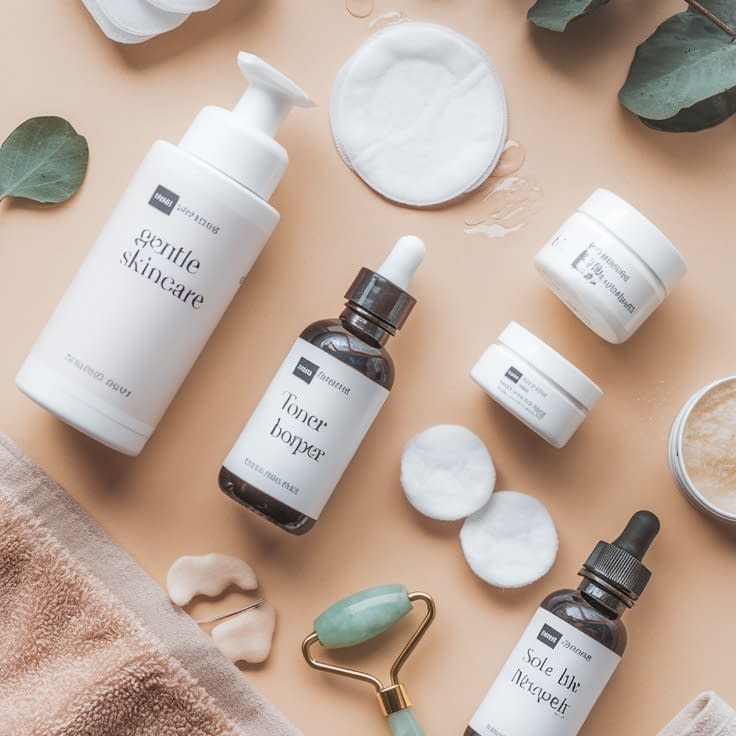
You don’t need luxury brands to get results. Focus on ingredient and function.
Budget routine (AM):
- Cleanser: Gentle gel or cream cleanser.
- Hydrating serum/toner: Hyaluronic acid or glycerin-based.
- Moisturizer: Simple ceramide or glycerin formula.
- Sunscreen: SPF 30 broad-spectrum (drugstore brands often excellent).
Budget routine (PM):
- Cleanser: Same gentle cleanser.
- Treatment: Low-cost niacinamide serum or a budget retinol (start low %).
- Moisturizer: The same as AM or a slightly richer cream.
Tips to save:
- Buy multi-taskers: a moisturizer with niacinamide or SPF combined products (but don’t rely on makeup with SPF as your sole protection).
- Look for actives in stable formulations: niacinamide, hyaluronic acid, basic retinol serums — they’re widely available cheaply.
- Use smaller sizes to test new products before committing to full price.
Affordable ingredient checklist:
- Glycerin, hyaluronic acid, niacinamide, ceramides, gentle BHA (salicylic acid), and mineral sunscreen — many budget brands include these.
Skincare Routine by Skin Type (Oily, Dry, Combination, Sensitive)
Tailor the core steps (cleanse, treat, moisturize, protect) to your type.
Oily / Acne-Prone
- AM: Gentle foaming/gel cleanser (salicylic acid if tolerated), water-based hydrating toner, niacinamide serum, lightweight oil-free moisturizer, broad-spectrum SPF 30+.
- PM: Double cleanse if wearing sunscreen; retinol or BHA treatment on alternate nights; lightweight moisturizer. Avoid heavy oils that clog pores.
Dry
- AM: Cream or milk cleanser, hydrating toner, hyaluronic acid serum, rich moisturizer with ceramides, SPF.
- PM: Gentle oil or balm cleanser (if wearing makeup), hydrating serum, richer night cream or sleeping mask. Limit strong exfoliants.
Combination
- AM: Gentle cleanser, hydrating toner, niacinamide serum, light moisturizer (or apply heavier moisturizer on cheeks), SPF.
- PM: Target treatments for the T-zone (BHA), hydrating creams for dry areas. Consider using two moisturizers for different zones.
Sensitive
- AM: Minimalist cleanse with non-foaming, fragrance-free cleanser, soothing toner (aloe/panthenol), ceramide moisturizer, mineral sunscreen.
- PM: Gentle cleansing, barrier-repairing moisturizer, avoid strong acids/retinoids unless recommended by a dermatologist. Patch test any new product.
Reactive / Rosacea-prone
- Focus on soothing ingredients (azelaic acid can help), avoid triggers (heat, alcohol, fragrance), and consult a dermatologist for prescription options.
Bonus: Healthy Habits for Naturally Glowing Skin
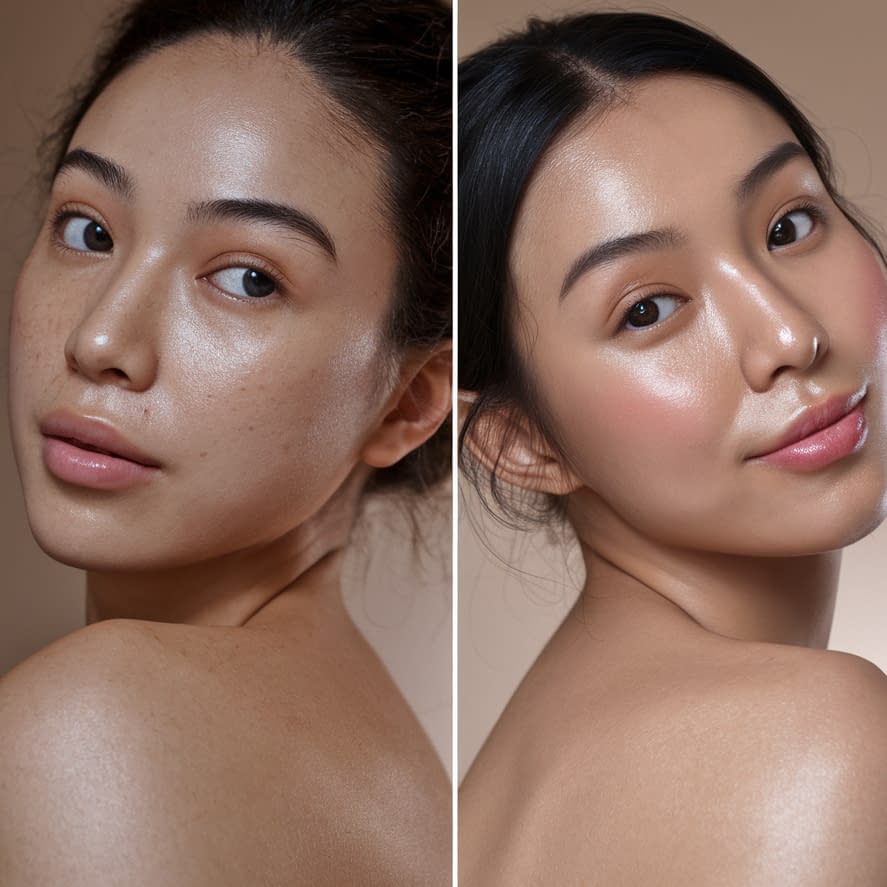
Skincare is supported by lifestyle.
Daily habits:
- Sleep: Aim for 7–9 hours — skin repairs during deep sleep cycles.
- Hydration: Drink water throughout the day; hydration helps, though topical HA has the most direct effect.
- Diet: Balanced diet rich in antioxidants (berries, leafy greens), omega-3s (fish, walnuts) supports skin health.
- Movement: Exercise increases circulation and supports skin oxygenation; shower and cleanse afterward to remove sweat.
- Stress management: Chronic stress raises cortisol which can worsen acne and barrier function. Try breathing, mindfulness, or walks.
- Avoid smoking: It accelerates skin aging and damages collagen.
- Clean pillowcases & phone screens: Reduce bacteria and oil transfer to facial skin.
Final Thoughts: Consistency Is the Secret to Clear Skin
Healthy skin is the result of consistent, gentle care over time. Start with a minimal, tolerable routine. Introduce one active at a time. Track how your skin responds, and be patient — many changes take 4–12 weeks. Prioritize sun protection and barrier-supporting ingredients (ceramides, hyaluronic acid, gentle cleansers). When in doubt, simplify: fewer, well-chosen products are better than many conflicting ones.
Your Most Asked Skincare Questions Answered
Q: How long before I see results?
A: For hydration and texture improvements you can notice in days to 2–4 weeks. For acne reduction, pigmentation, or collagen-building (retinol), expect 8–12+ weeks of consistent use.
Q: Can I use vitamin C and niacinamide together?
A: Yes — modern formulas are stable together. If you’re sensitive, try one at a time until you’re sure your skin tolerates both.
Q: Do I need toner?
A: Not strictly. Many modern “toners” are hydrating or treatment step additions; they’re useful but not mandatory. Use a toner for targeted benefits (hydration or mild exfoliation).
Q: How do I stop purging from retinol or acids?
A: Distinguish between purging (temporary worsening as skin renovates) and irritation. Purging usually appears within weeks and resolves as new skin cycles through. If severe, stop and allow skin to calm, then reintroduce more slowly. Consult a dermatologist if unsure.
Q: Should I moisturize if I have oily skin?
A: Yes. Use a lightweight, non-comedogenic moisturizer. Skipping moisturizer can make skin produce more oil.
Q: Is it OK to layer multiple actives?
A: Careful layering is possible, but avoid stacking strong acids + retinol + exfoliants at once. Introduce slowly and monitor for irritation.
Q: What’s the best sunscreen for acne-prone skin?
A: A gel or fluid, non-comedogenic, broad-spectrum SPF 30+; mineral tints can be helpful. Look for “non-comedogenic” labeling and lightweight formulas.
Q: Can I use retinol while pregnant or breastfeeding?
A: Topical retinoids are generally not recommended during pregnancy — check with your healthcare provider for guidance.
Q: How do I patch-test a product?
A: Apply a small amount to the inside of your wrist or behind the ear for 48 hours and watch for redness, burning, or blistering.


